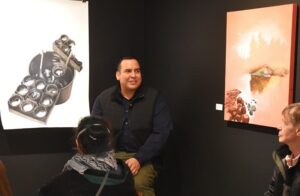Through the eyes of artist Ray Fox

By Kelly Anne Smith
NORTH BAY—Being close to nature in Northern Ontario again has inspired the art of Ray Fox.
Speaking at his solo exhibition, Pasweweshin, at the Good Atlas Gallery in North Bay, Fox explained that the name of his show is an echo, reverberating across long distances like a loon call. From Wiikwemkoong Unceded Territory, Fox gave the process for his striking Maang Loon wading in fluid detail in charcoal.
Fox has been drawing since he was a child being raised in a family with aunts, uncles, and cousins who are artists.
“The first thing I really fell in love with is drawing.”
As a young artist, Fox says he had a complex relationship with how he identified as an Indigenous artist.
“Because the work that I was most interested in was representational drawing. I was really attracted to drawing exactly what I could I see in front of me like landscapes and imagery that I problem-solve. How do I achieve that in art-making? Drawing and painting became that for me since I was a kid.”
His parents encouraged Ray’s passion for art. He studied at BealART in London and Ontario College of Art & Design University (OCAD U).
Ray saw a future for himself in art when he was introduced to sculpture, textiles, and printmaking. At OCAD U for drawing and painting, he almost made a switch to sculpture and installation.
“I love creating an experience that you can walk around it and keep experiencing from different angles and maybe I’ll explore that again one day.”
Explaining his influences, Ray talked about being 12 years old when his creative spark was lit by an article in The Spirit.
“I remembering opening it up and seeing, for the first time, work by artist Carl Beam. It was The North American Iceberg (1985). I remember my mind being blown at that moment because I’d never seen Indigenous art look like that. It was so beyond everything that I thought Indigenous art could be and immediately saw myself in that… I definitely saw his way of thinking differently about the world and how to record landmark moments in your personal story or life, connection to culture, the environment around you, the way we work the plants and wildlife… From that moment, I grabbed the magazine and rushed off to my Mom and said, ‘I need to see more of this guy’s work; he is amazing; and I’m going to meet him one day.’ And I remember my Mom looked at the magazine and laughed at me. She said, ‘Ray, Carl lives across the street.”
Ray recalls that a couple of days later, they went to go see him.
“His art works were huge. He was doing water colour, paper collages that were six feet tall. And he was grabbing them out of his studio and putting them on his lawn to show us. It was all handmade paper. It was mind-blowing to me that this guy lived across the street and I didn’t even realize.”
Leaving the big city, Ray moved back to Northern Ontario to start seeing everything around himself differently.
“When I was a kid, a Two-Spirit 14-year-old, the first thing I wanted to do was leave Northern Ontario. It was kind of hard, right? I wanted to be an artist, too. When I came back, I found myself here. I spent so much time in big cities trying to find myself. Meanwhile, I found myself when I came back.”
Ray explains that he started doing a collection of drawings that were wildlife-centred.
“What you would see in Northern Ontario and then finding ways that I had a connection to that drawing.”
The Sault Ste. Marie artist talks about each one of his works in the exhibition – Hill Bros. Shkaabewis, Waterfall Gakijiwan, Maang Loon, Preserving Cultural Knowledge and “Prayer” Serpent River.
There is spirit in Ray’s charcoal as he considers cultural and geographical representation of his subjects. He talked of seeing cans out of place for days before he sat to create Hill Bros.
“For me, this is a smudge can we use in our ceremonies back home. It’s a recycled can fitted with a loop of wire you can hold on to and smudge the lodge and the doorway. When I was a teenager, my family started following a more traditional lifestyle. We started going to ceremonies and one of my first jobs in the lodge was a helper, the name of which is shkaabewis.”
Ray intrigues with the work Preserving Cultural Knowledge with hands in negative space.
“When I was a kid, my Dad was a traditional harvester for making traditional medicines. I remember we had tarps and bags of medicine hanging and drying,” he recalls. “This is a little bit of a snapshot of portioning out minagun. It’s a topical treatment you would use for pain, arthritis, cuts. The negative space of the hands, it’s like when you are asking, maybe in prayer, for help or a sign. Your ancestor is answering that question. Or to bring you back to when you had that recipe for minagun.”
The exhibition of Ray Fox’s Pasweweshin is complex in thought, technique, and talent. The artist’s use of the Anishinaabemowin word pasweweshin is a reminder that at different times in his life there are echos that he needed to hear. And echos can be metaphors, too, Ray says.
“If you ask the universe a question, you get answers back in interesting ways.”
Ray’s exhibition was featured in Good Atlas from November 16 to December 8.

